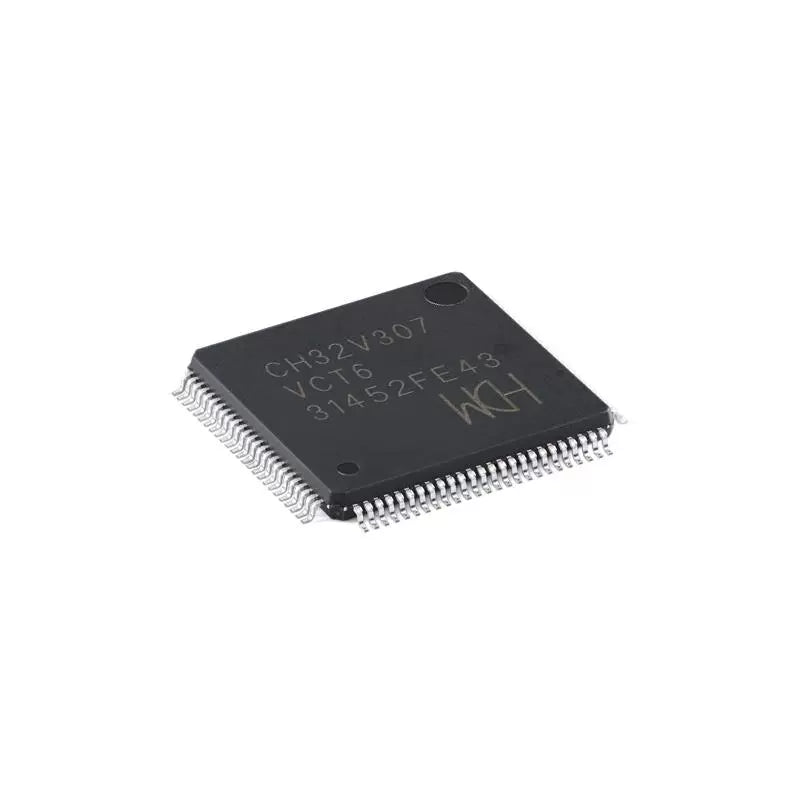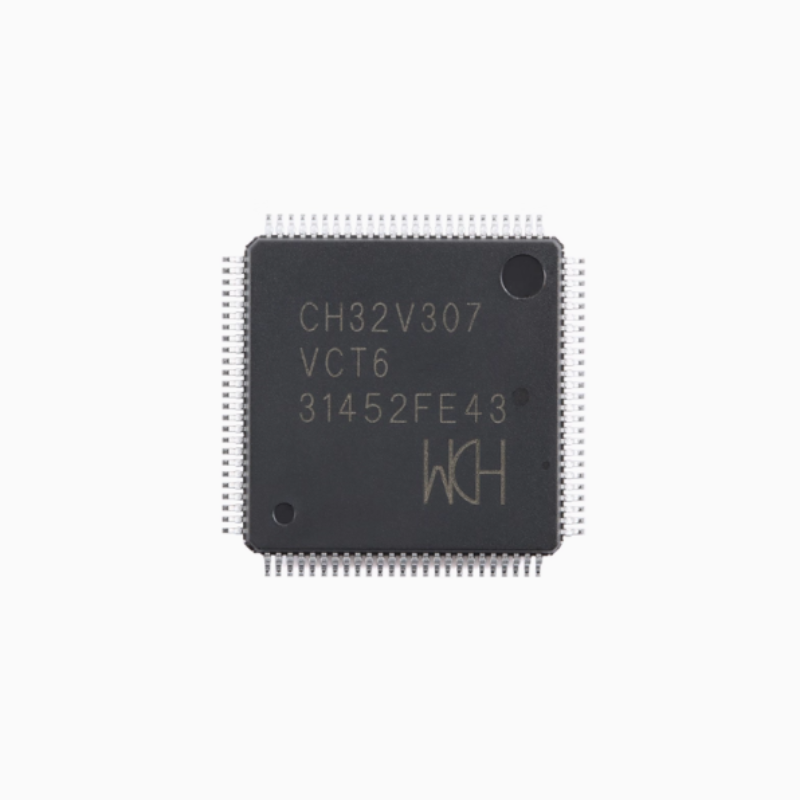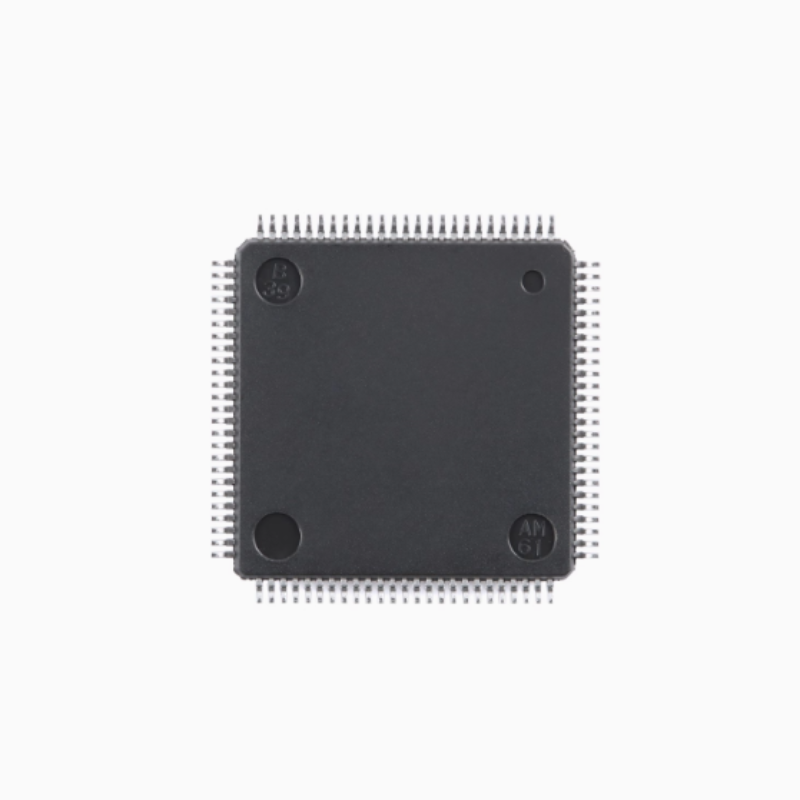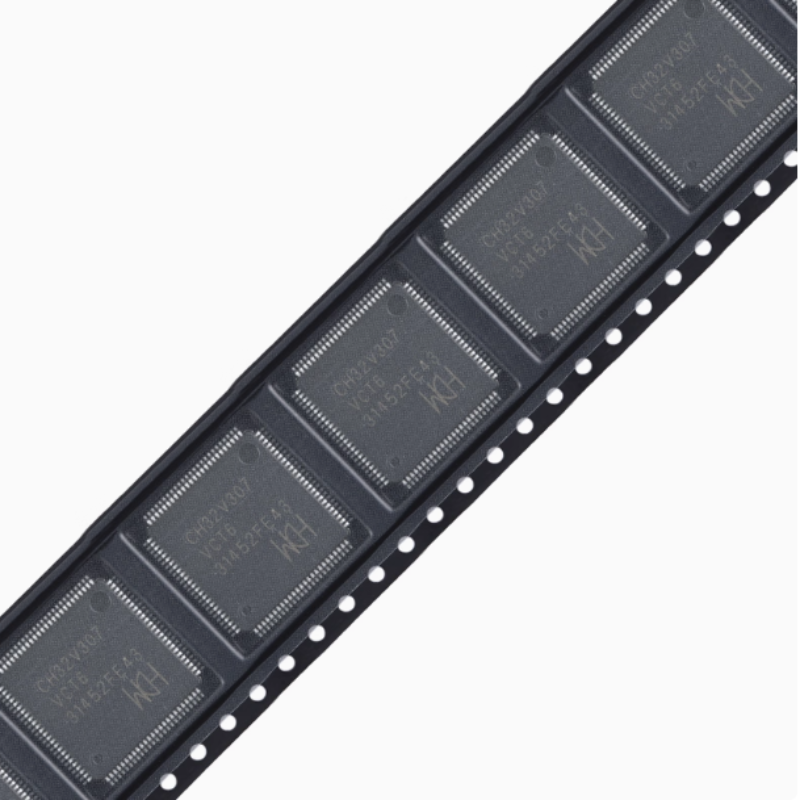Original Genuine CH32V307VCT6 LQFP-100 RISC-V Core 32-Bit Microcontroller -MCU
Original Genuine CH32V307VCT6 LQFP-100 RISC-V Core 32-Bit Microcontroller -MCU
Regular price
¥12.50 CNY
Regular price
¥0.00 CNY
Sale price
¥12.50 CNY
Quantity
Couldn't load pickup availability

CH32V307VCT6/LQFP-100
RISC-V core 32-bit microcontroller -MCU
Product introduction
The CH32V series is an industrial-grade general-purpose microcontroller designed based on the Qingke RISC-V core, including the CH32V305 connected MCU, CH32V307/CH32V317 interconnected MCU, and CH32V208 wireless MCU, etc. The CH32V30x and CH32V31x series are based on the Qingke V4F microprocessor design, supporting single-precisionfloating-point instructions and fast interrupt response, and supporting zero-wait operation at a 144MHz main frequency. It provides 8 groups of serial ports, 4 groups of advanced motor PWM timers, SDIO, DVP digital image interfaces, 4 groups of analog operational amplifiers, dual ADC units, and dual DAC units. It is equipped with a built-in USB2.0 high-speed PHY transceiver (480Mbps), a Gigabit Ethernet MAC controller, and 10-megabit physical layer transceivers, 10/100-megabit physical layer transceivers (only applicable to CH32V317), etc.
Product details
Product features
Core:
- Qingke 32-bit RISC-V4F core, with multiple instruction set combinations
- Fast programmable interrupt controller + hardware interrupt stack
- Branch prediction, conflict handling mechanism
Memory:
- Can be equipped with 480KB program storage area CodeFlash(zero-wait application area + non-zero-wait data area)
-28KB system BootLoader storage area
-1288 system non-volatile configuration information storage area
-1288 User-defined information storage area
Power management and low power consumption:
- The rated VDD for system power supply is 3.3V
- The independent power supply Vo rating of the GP10 unit is 3.3V
- Low-power modes: Sleep, stop, standby
System clock, reset:
- Built-in factory-calibrated 8MHz RC oscillator
- Built-in RC oscillator with approximately 40kHz
- Built-in PLL, with an optional CPU clock of up to 144MHz
- External support for high-speed oscillators ranging from 3 to 25MHz
- Externally supports a 32.768kHz low-speed oscillator
Power-on and power-off reset, programmable voltage monitor
Real-time clock RTC: 32-bit independent timer
Two groups of 18-channel universal DMA controllers:
-18 channels, supporting circular buffer management
- support TIMX/ADC/DAC/USART/I2C/SP1/12 s/SD10
4 groups of operational amplifiers and comparators: Connect ADC and TIMx
Two sets of 12-bit digital-to-analog conversion Dacs
Two groups of 12-bit analog-to-digital conversion ADCs:
-16 external signal channels +2 internal signal channels
- Dual ADC conversion mode
Multiple sets of timers:
-4 16-bit advanced timers, supporting dead zone control and emergency Brake, providing PWM complementary output for motor control
-4 16-bit general-purpose timers, providing input capture/output comparison /PWM pulse counting and incremental encoder input
Two basic timers:
-2 watchdog timers (standalone and windowed types)
- System time base timer: 64-bit counter
Multiple communication interfaces:
-8 USART interfaces (including 5 UART)
-2 12C interfaces (supporting SMBuS/PMBus)
-3 SPI interfaces (SPI2 and SPI3 for 12S2 and 12S3)
-USB2.0 full-speed host/device interface with built-in PHY
-USB2.0 full-speed 0TG interface
-USB2.0 high-speed host/device interface with built-in PHY
-2 groups of CAN interfaces (2.0B active)
-SDIO host interface (MMC, SD/SDIO card and CE-ATA)
-FSMC memory interface
-Digital Image Interface (DVP)
-Gigabit Ethernet MAC controller, 10 Gigabit PHY transceiver
-10/100 MHZ PHY transceiver (CH32V317 only)
Fast GPIO port:
-80 I/O ports, mapping 16 external interrupts
Security features :CRC calculation unit, 96-bit chip unique ID
Debugging mode: Serial 2-wire debugging interface
Packaging forms :LQFP, QFN and TSSOP
Specification information
The CH32V30x and CH32V31x series are 32-bit RISC-V core MCUS based on the Qingke V4F microprocessor, operating at a frequency of 144MHz. It is equipped with high-speed built-in memory, and multiple buses work synchronously in the system structure, providing rich peripheral functions and enhanced I/ O ports. This series of products is equipped with 2 12-bit ADC modules, 2 12-bit DAC modules, multiple sets of timers, multi-channel touch key capacitance detection (TKey), and other functions. It also includes standard and dedicated communication interfaces :120, 12S, SPI, USART, SDIO, CAN controller, USB2.0 full-speed host/device controller, USB2.0 high-speed host/device controller (with built-in 480Mbps transceiver), digital image interface, Gigabit Ethernet controller, etc. The rated working voltage of the product is 3.3V, and the working temperature range is -40℃ to 85℃. It is of industrial grade. Supports multiple power-saving working modes to meet the low-power application requirements of the product. Among the series of products, each model varies in terms of resource allocation, the number of peripheral devices, and peripheral device functions. Choose according to your needs.
Product function
2.5.1 RISC-V4F processor
RISC-V4F supports the IMAFC subset of the RISC-V instruction set and adds single-precision floating-point operations. The processor is managed in a modular way internally, including units such as the Fast Programmable Interrupt Controller (PFIC), memory protection, branch prediction mode, and extended instruction support. Multiple sets of external buses are connected to external unit modules to achieve interaction between external functional modules and the kernel.
The Qingke microprocessor, with its features such as an extremely simple instruction set, multiple working modes, and modular customization and expansion, can be flexibly applied in the design of microcontrollers for various scenarios, such as small-area low-power embedded scenarios and high-performance application operating system scenarios.
Support machine and user privilege modes
Fast Programmable Interrupt Controller (PFIC)
Multi-level hardware interrupt stack
Serial 2-wire debugging interface
Standard memory protection design
Static or dynamic branch prediction, efficient jumping, and conflict detection mechanisms
Custom extension instructions
Products photography













